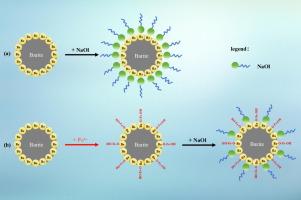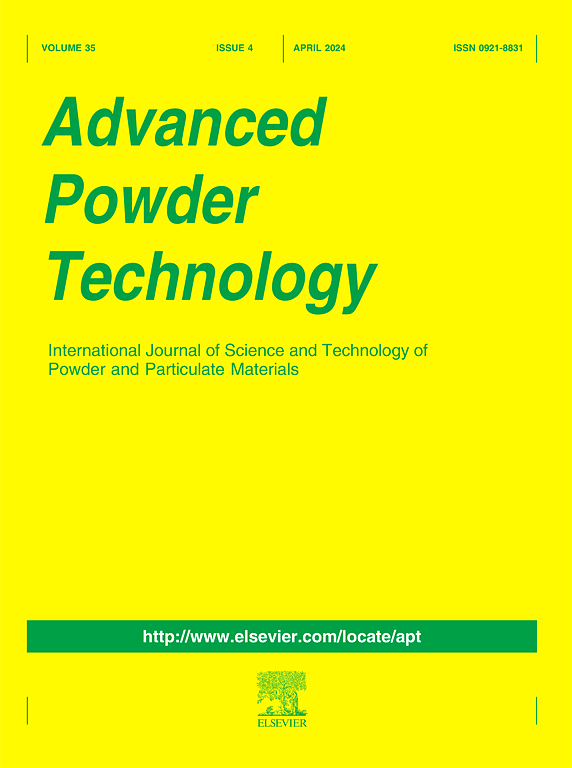Effect of Fe3+ on barite flotation and investigation of its adsorption mechanism
IF 4.2
2区 工程技术
Q2 ENGINEERING, CHEMICAL
引用次数: 0
Abstract
During the flotation process of barite ore, the release and adsorption of surface ions from associated minerals can inhibit or activate barite flotation. However, the effect of Fe3+ dissolved from associated iron minerals in barite ore on its flotation performance has not been reported, and the mechanism of Fe3+ interaction with barite surfaces requires further investigation. This study systematically investigated the effect of Fe3+ on barite flotation and its adsorption mechanism using a multidisciplinary approach combining flotation experiments, X-ray diffraction (XRD), Zeta potential measurements, Fourier transform infrared spectroscopy (FTIR), X-ray photoelectron spectroscopy (XPS), solution chemistry calculations, adsorption capacity determination, and contact angle analysis. The results demonstrated that Fe3+ inhibits barite flotation when sodium oleate is employed as the collector. This inhibition arises from the formation of a Ba(-O-Fe-OH) complex on the barite surface, which reduces the available adsorption sites for sodium oleate. This reduction in sodium oleate adsorption diminishes surface hydrophobicity, thereby deteriorating barite floatability.

Fe3+对重晶石浮选的影响及其吸附机理研究
在重晶石浮选过程中,伴生矿物表面离子的释放和吸附可抑制或激活重晶石浮选。然而,重晶石中伴生铁矿物中溶解的Fe3+对其浮选性能的影响尚未见报道,Fe3+与重晶石表面相互作用的机理有待进一步研究。本研究采用浮选实验、x射线衍射(XRD)、Zeta电位测量、傅里叶变换红外光谱(FTIR)、x射线光电子能谱(XPS)、溶液化学计算、吸附量测定、接触角分析等多学科方法,系统研究了Fe3+对重晶石浮选的影响及其吸附机理。结果表明,以油酸钠为捕收剂时,Fe3+对重晶石浮选有抑制作用。这种抑制作用是由于在重晶石表面形成Ba(-O-Fe-OH)络合物,从而减少了油酸钠的可用吸附位点。油酸钠吸附的减少降低了表面疏水性,从而恶化了重晶石的可浮性。
本文章由计算机程序翻译,如有差异,请以英文原文为准。
求助全文
约1分钟内获得全文
求助全文
来源期刊

Advanced Powder Technology
工程技术-工程:化工
CiteScore
9.50
自引率
7.70%
发文量
424
审稿时长
55 days
期刊介绍:
The aim of Advanced Powder Technology is to meet the demand for an international journal that integrates all aspects of science and technology research on powder and particulate materials. The journal fulfills this purpose by publishing original research papers, rapid communications, reviews, and translated articles by prominent researchers worldwide.
The editorial work of Advanced Powder Technology, which was founded as the International Journal of the Society of Powder Technology, Japan, is now shared by distinguished board members, who operate in a unique framework designed to respond to the increasing global demand for articles on not only powder and particles, but also on various materials produced from them.
Advanced Powder Technology covers various areas, but a discussion of powder and particles is required in articles. Topics include: Production of powder and particulate materials in gases and liquids(nanoparticles, fine ceramics, pharmaceuticals, novel functional materials, etc.); Aerosol and colloidal processing; Powder and particle characterization; Dynamics and phenomena; Calculation and simulation (CFD, DEM, Monte Carlo method, population balance, etc.); Measurement and control of powder processes; Particle modification; Comminution; Powder handling and operations (storage, transport, granulation, separation, fluidization, etc.)
 求助内容:
求助内容: 应助结果提醒方式:
应助结果提醒方式:


